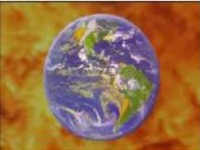Mapping Climate Change
 GLOBE-Net - A new map illustrating the global consequences of failing to keep temperature change to under 2 °C was launched today by the UK Government, in partnership with the Met Office.
GLOBE-Net - A new map illustrating the global consequences of failing to keep temperature change to under 2 °C was launched today by the UK Government, in partnership with the Met Office. The map was developed using the latest peer-reviewed science from the Met Office Hadley Centre and other leading impact scientists. The poster highlights some of the impacts that may occur if the global average temperature rises by 4 °C above the pre-industrial climate average.
Ahead of December’s international climate change talks in Copenhagen, the Government is aiming for an agreement that limits climate change as far as possible to 2 °C. Increases of more than two degrees will have huge impacts on the world.
The poster shows that a four degree average rise will not be spread uniformly across the globe. The land will heat up more quickly than the sea, and high latitudes, particularly the Arctic, will have larger temperature increases. The average land temperature will be 5.5 degrees above pre-industrial levels.
The impacts on human activity shown on the map are only a selection of those that may occur, and highlight the severe effects on water availability, agricultural productivity, extreme temperatures and drought, the risk of forest fire and sea-level rise
Agricultural yields are expected to decrease for all major cereal crops in all major regions of production. Half of all Himalayan glaciers will be significantly reduced by 2050, leading to 23% of the population of China being deprived of the vital dry season glacial melt water source.
The Foreign Secretary, David Miliband said: “We cannot cope with a four degree world. This map clearly illustrates the scale of the challenge facing us today - climate change is a truly global problem that needs a global solution and it is a solution we have within our grasp.
 “But to tackle the problem of climate change, all of us - foreign ministries, environment ministries, treasuries, departments of defence and all parts of government and societies - must work together to keep global temperatures to two degrees. It is only by doing this that we can minimise the huge security risks presented by a future four degree world.”
“But to tackle the problem of climate change, all of us - foreign ministries, environment ministries, treasuries, departments of defence and all parts of government and societies - must work together to keep global temperatures to two degrees. It is only by doing this that we can minimise the huge security risks presented by a future four degree world.”
Ed Miliband, Energy and Climate Change Secretary said: “This map shows that the stakes couldn’t be any higher at the Copenhagen talks in December. Britain’s scientists have helped to illustrate the catastrophic effects that will result if the world fails to limit the global temperature rise to two degrees. With less than 50 days left before agreement must be reached, the UK’s going all out to persuade the world of the need to raise its ambitions so we get a deal that protects us from a four degree world.”
Vicky Pope, Head of Climate Change Advice at the Met Office, said: “If emissions continue at the current rate the global average temperature are likely to rise by 4 °C by the end of this century or even substantially earlier. The science tells us that this will have severe and widespread impacts in all parts of the world, so we need to take action now to reduce emissions to avoid water and food shortages in the future.”
For More Information: metoffice.gov.uk
You can return to the main Market News page, or press the Back button on your browser.

